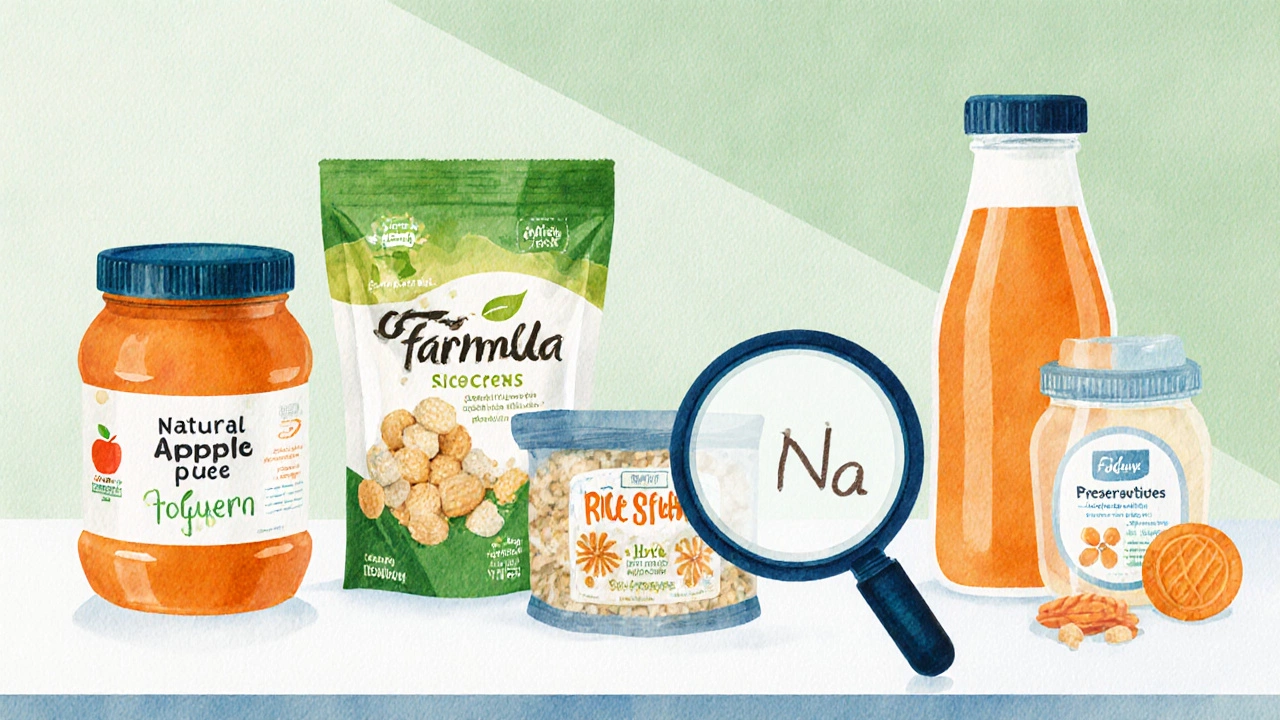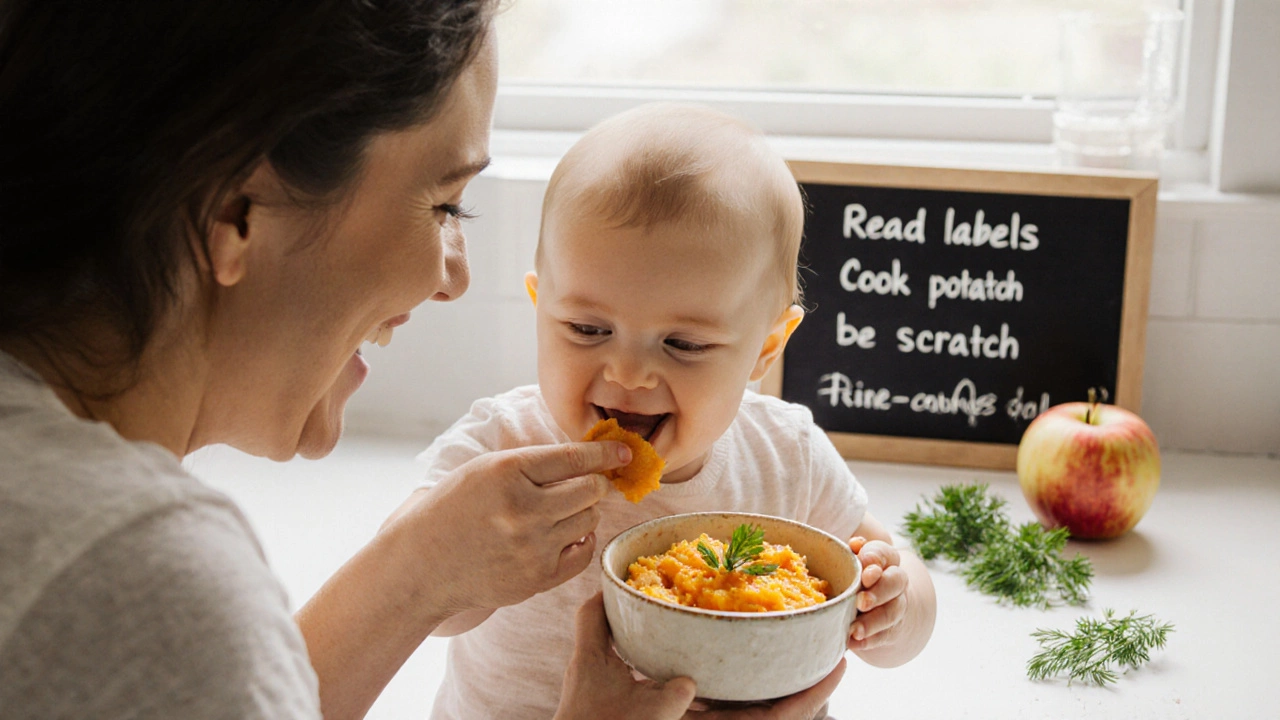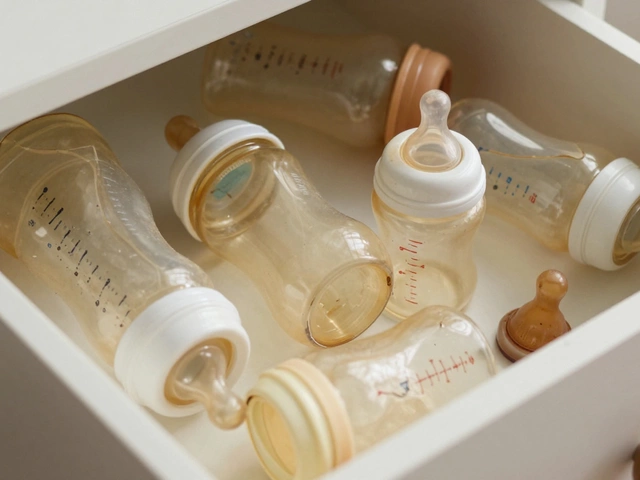
Baby Salt Intake Calculator
Recommended Daily Sodium Limits
- 0-6 months: Maximum 40 mg/day
- 7-12 months: Maximum 120 mg/day
Safe Food Options
- Breast milk
- Infant formula
- Pureed vegetables and fruits
- Homemade baby foods without added salt
Key Takeaways
- Infants need only a tiny amount of sodium - far less than a pinch of salt.
- Too much salt can overload a baby’s kidneys, raise blood pressure, and disrupt electrolyte balance.
- Breast milk and properly prepared homemade foods naturally provide the right sodium levels.
- Check ingredient labels - many baby‑friendly products hide sodium under "flavourings" or "preservatives".
- Follow WHO and local health‑authority guidelines: no added salt until after the first year.
Ever wonder why pediatricians tell you to skip the salt shaker for your newborn? The short answer is that a baby’s body isn’t built to process the sodium load that even a tiny dash of table Salt is made of. In the first 12 months, baby kidneys can filter only about 40mg of sodium per day - roughly the amount you’d find in a single grain of sea salt. Anything more pushes the tiny organs into over‑drive, which can set the stage for health issues later on.
What Exactly Is Salt and Why Does Sodium Matter?
Salt is the everyday name for sodium chloride, a mineral that delivers two essential elements: Sodium and chloride. Sodium helps conduct electrical signals in the body, regulates fluid balance, and supports muscle function. In adults, a modest amount is vital - think of it as the “fuel” that keeps nerves firing. But infants have a different fuel‑mix requirement.
How Much Sodium Does an Infant Really Need?
The World Health Organization (WHO) and most national health agencies recommend a maximum of 40mg of sodium per day for babies aged 0‑6months, and 120mg per day for 7‑12months. That’s roughly the sodium content of 2‑3ml of breast milk or a single ounce of homemade vegetable puree. By comparison, a single pinch of table salt can add 400mg or more - ten times the recommended limit for a 6‑month‑old.
Why Babies Can’t Handle More Salt
Three core reasons explain the restriction:
- Kidney Capacity: Newborn kidneys are still developing. Kidney glomeruli (filtering units) have limited surface area, so they can’t excrete excess sodium efficiently. The result? Sodium builds up in the bloodstream.
- Blood Pressure Sensitivity: Elevated sodium raises blood volume, which can increase blood pressure. While adults can adapt over years, infants’ cardiovascular systems are delicate. Even modest increases may strain the heart and blood vessels.
- Electrolyte Imbalance: Sodium works hand‑in‑hand with potassium, calcium, and magnesium to keep cells stable. Too much sodium throws off this electrolyte balance, leading to dehydration, irritability, and in severe cases, seizures.

Hidden Sources of Salt in Baby Food
If you think you’re safe because you’re feeding your baby pureed carrots or store‑bought rice cereal, think again. Many processed infant foods add sodium to improve taste or preserve texture. Look for these sneaky culprits on the label:
- "Natural Flavour" - often a sodium‑based compound.
- "Preservatives" - many, like sodium benzoate, contain salt.
- "Fortified" - added vitamins sometimes come with sodium carriers.
- Baby‑snack pouches - can contain up to 80mg per serving.
Even “organic” or “no added sugar” products may contain sodium. The safest route is to prepare meals from scratch using fresh ingredients.
How Breast Milk and Properly Prepared Foods Meet Sodium Needs
Breast milk is nature’s perfect formula. It delivers about 30‑35mg of sodium per 100ml - exactly the amount a baby needs without risking overload. For formula‑fed infants, most commercial Infant Formula brands are formulated to stay within the recommended limits, but you still need to watch for added flavor packs.
When you transition to solid foods (around 6 months), aim for recipes that rely on the natural sodium of the ingredients. A simple sweet potato‑apple mash, a banana‑avocado blend, or steamed green beans mashed with a splash of breast milk provide vitamins, fiber, and the tiny sodium dose your toddler needs.
Practical Tips to Keep Your Baby’s Diet Salt‑Free
- Read Labels Like a Detective: Look for “sodium”, “Na”, or “salt” listed in the nutrition facts. If the amount is >10mg per serving, skip it.
- Cook From Scratch: Use fresh herbs (parsley, dill) for flavor instead of salt.
- Avoid Processed Meats: Even tiny pieces of chicken sausage can pack 200mg of sodium.
- Rinse Canned Goods: If you must use canned fruit or vegetables, rinse them under water to wash away brine.
- Delay Seasonings: Wait until after the first birthday before introducing a pinch of sea salt or soy sauce.
Common Myths About Salt and Baby Growth
Myth 1: “Salt helps babies grow faster.” Reality: Growth is driven by protein, calories, and overall nutrient balance, not sodium. Extra salt can actually stunt growth by stressing the kidneys.
Myth 2: “All salt is the same, so a little won’t hurt.” Reality: Table salt, sea salt, and kosher salt all deliver the same amount of sodium per gram. The only difference is texture.
Myth 3: “If baby loves salty‑tasting foods, they must need more salt.” Reality: Babies develop taste preferences based on exposure. If they’re accustomed to salty flavors early, they may crave them later, leading to unhealthy eating habits.

Quick Checklist for a Low‑Salt Baby Diet
- Stick to breast milk or approved formula for the first 6 months.
- Introduce single‑ingredient purees without added seasoning.
- Inspect every packaged food for sodium content before buying.
- Avoid processed snacks, sauces, and cheese spreads.
- Schedule a pediatric check‑up at 6 months to discuss your baby’s nutrition plan.
What Happens If You Accidentally Give Too Much Salt?
Small slip‑ups-like adding a pinch of salt to a vegetable puree-won’t cause lifelong damage, but they can lead to short‑term symptoms:
- Increased thirst and frequent urination.
- Swelling of hands or feet (edema).
- Redness or irritability due to mild dehydration.
- Elevated blood pressure readings at a routine check‑up.
If you notice these signs, offer extra breast milk or water (if your pediatrician says it’s safe) and monitor the baby’s output. Persistent symptoms warrant a doctor’s visit.
Reference Table: Recommended Sodium Intake vs. Common Foods
| Food Item | Sodium (mg) | Meets Infant Limit? |
|---|---|---|
| Breast milk (100ml) | 30‑35 | Yes |
| Infant formula (100ml) | 40‑45 | Yes |
| Pureed sweet potato (½ cup) | 15 | Yes |
| Store‑bought apple puree (100g) | 70 | No |
| Baby rice cereal (1tsp) | 30 | Borderline |
| Processed chicken sausage (1slice) | 180 | No |
Frequently Asked Questions
Can I add a pinch of salt to homemade baby food?
No. Even a pinch can exceed the daily sodium limit for infants under one year. Use herbs or a splash of fruit juice for flavor instead.
How do I know if my baby’s formula has too much sodium?
Check the nutrition label. Most reputable formulas list sodium around 40‑45mg per 100ml, which aligns with WHO recommendations.
Is low‑sodium baby food available in supermarkets?
Yes, look for products labeled “no added salt” or “sodium‑free”. Still read the ingredient list because sodium can hide under other names.
Will my baby miss the taste of salt later?
Taste buds adapt. Children who grow up with low‑salt foods often develop a preference for fresher, less salty flavors as they age.
Can dehydration be a sign of too much salt?
Yes. Excess sodium pulls water out of cells, leading to increased thirst and reduced urine output, which can quickly become dehydration in babies.






